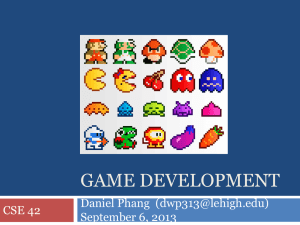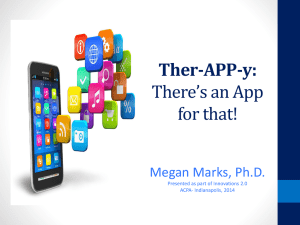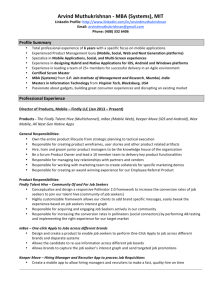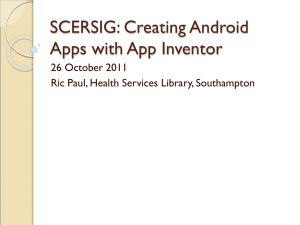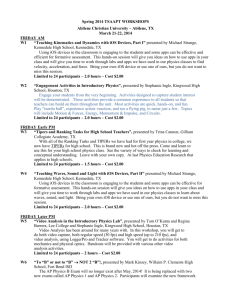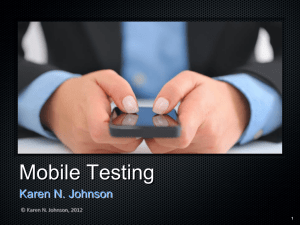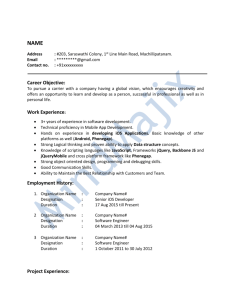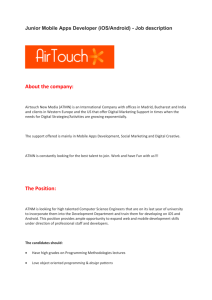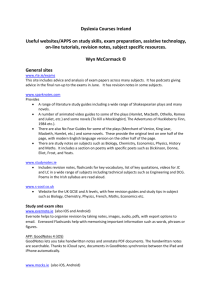Using Mobile Technology to Promote Independence for
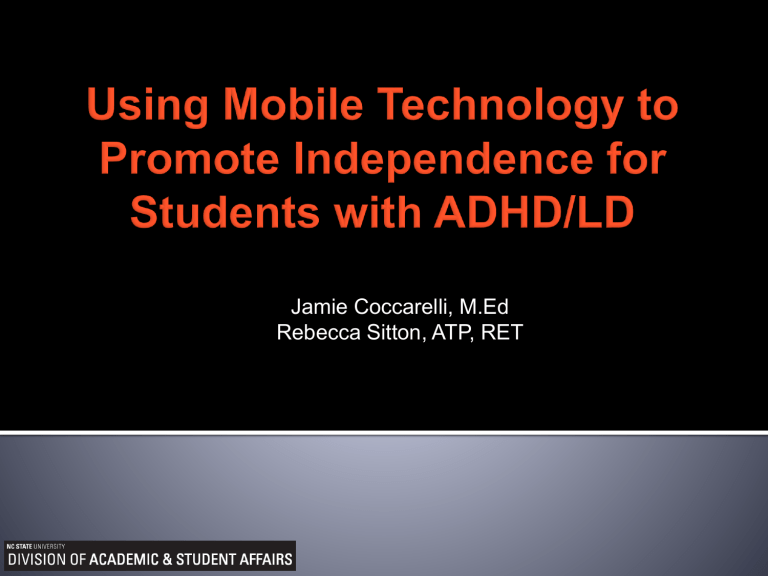
Jamie Coccarelli, M.Ed
Rebecca Sitton, ATP, RET
You are a small disability services office and want to provide better accommodations for your students with
ADHD and/or Learning Disabilities.
You want to learn more about technology to assist students with ADHD and/or
Learning Disabilities.
Gain an understanding of the functional limitations of students with ADHD and
Learning Disabilities.
Take away some free or low cost technology tools to accommodate those functional limitations in the classroom.
Fall 2008: 584 students registered with
DSO on the 12 th day of class.=
Fall 2013: 1021 students registered with
DSO on the 12 th day of class
78.4% increase in students with no increase in staff
Share common functional limitations of:
Organization & Executive Function
Sustained Attention and Concentration
Reading
Writing
Missing assignment/project due dates
Setting unrealistic goals for assignment/project completion (i.e. one night for 10 page paper).
Not following the given rubric
Losing notes from lecture
Missing class
Missing registration dates
Unable to focus in lecture
Missing notes on the board/power point
Not listening to the auditory portion of class
(lecture)
Unable to focus while studying at home
Get distracted by pictures in text, advertisements on websites
Get distracted by roommates, TV, electronics
Word reading (dyslexia)
Reading fluency
Reading comprehension
Task persistence: a skill that is especially important for successful reading of expository text, such as history and science textbooks, newspapers, and voter pamphlets.
Written expression
Dysgraphia
Visual-spatial difficulties: trouble processing what the eye sees
Language processing difficulty: trouble processing and making sense of what the ear hears
Laptops
MacBook AIR
Netbooks/PC’s
Tablets
iPads
Kindles
Surface
Phones
iPhone
Android
Windows
Come in the form of:
Built in OS features
Software
Apps
Browser AddOn’s or Extensions
Accessibility features already in your technology that can assist students.
Apple Accessibility
Features
Dictionary
Text to Seech
Word Completion
Voice Recognition
Contrast
VoiceOver
Windows
Accessibility
Features
Voice Recognition
Narrator
Contrast
Chromebook
Accessibility
Features
Speech to text
iOS Accessibility
Features
Speech to Text
Voice Over
Speech Selection
Video and Auditory Engagement
Apps and software for reading digital text aloud (with/without highlighting)
Diagnosed LD – meet the requirements of organic impairment
Bookshare
Learning Ally
ADHD – and general assistance
CourseSmart
eBooks (Adobe Digital Edition)
Kindle
ibooks
Natural Reader
(Free)
Available in PC &
MAC Download, iOS,
Android, Google Play
Speak Selection
(iOS) built into accessibility features
Voice Reading
IVONA :
Moon+Reader
CoolReader
Webpage Reader
Voice Reading
Webpage Reader
What are Extensions? Some of my Favorites:
Small programs that add new features to your browser and personalize
TLDR
Clearly
SpeakIt your browsing experience .
Cruxlight
Chrome Web Store
Grammarly
Readability
Solutions for helping students capture content to process at a later time .
Audio Recordings
▪ Livescribe Pen
▪ Recording Apps on Tablets
Collaborative Notes
▪
Google Docs
▪
Evernote
▪
OneNote
Every student can benefit from using this technology (exception could be student with significant hearing impairments)
Visual and Auditory Tool
Ability to change playback speed to adjust for audio processing skills
3 pens currently on the market – Echo,
Sky, Smartpen 3
Notability
App records audio
Imports PDF’s
Imports PowerPoints
Annotate on imports
Add pictures and web clippings
MindMapping Software
An alternate to collect and visualize ideas.
Mindmeister –Cloud based, Google Play & iOS app available.
Xmind – MAC, PC, Linux
MindMaple – MAC, PC, iOS
Grammar Checking
Tools to independently check for Grammatical errors.
▪ Grammarly – Cloud Based (also Chrome Extension)
▪ Grammarbase – Cloud Based (Dyslexia friendly)
Voice Recognition is a good tool for students with Written Expression Disorders
Allows a student to vocalize their thoughts and have them written out.
Great tool for spelling issues and dysgraphia.
Available in Windows , Mac , iOS , and Google
How to set up
Windows Speech
Recognition
How to set up Mac
Speech
Build into iPhones/iPads
QUIZLET STUDYBLUE
Paper Planners
Digital Planners/Apps
Mobile Alerts
Focus Reminders
List Apps/Features
Cloud Based so accessible across devices.
• Studious
• Android App Only
• Phone silencer during class
• Manage study schedule.
• Reminders for assignments and tests
Apple App
Note taking with Recording
Date Organizer for
Homework, assignments and exams, to do list with notifications
Import PDFs and other docs from the web and from email attachments
Generate and print your weekly class schedule
Assignment Calculators
University of Toronto
SELF CONTROL APP
•
•
MAC COMPUTER
ONLY
ONCE SET – NO WAY
TO GET ACCESS TO
WEBSITES UNTIL
TIME IS UP
Stay Focused – Chrome Extension
Cold Turkey - Windows
